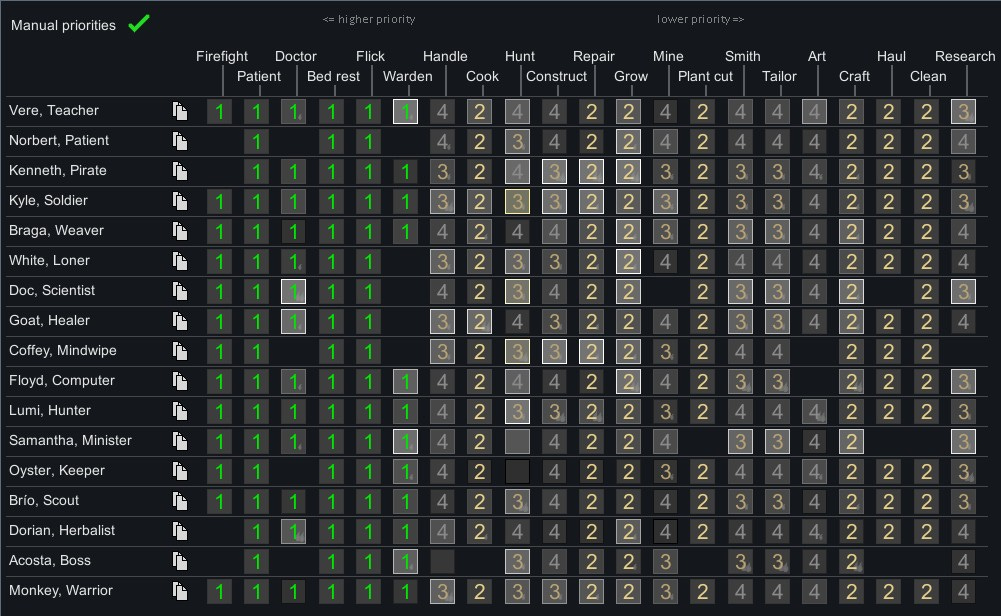
Introduction
If you’re like me, you have a lot on your plate. Between family, work, side hustles, and everything else, you’re consistently pulled in several directions, juggling multiple projects simultaneously.
Without clear boundaries, it’s easy to become blended — moments when your brain is flooded with thoughts about several parts of your life, such as worrying about work while with family or vice versa. When this happens, we lose our ability to focus, limiting our ability to do our best work.
One way to minimize the frequency and severity of these moments is to develop a prioritization system. While we might intuitively know what we should be working on, formally defining one ahead of time simplifies your decision-making process so you don’t get bogged down when conflicts inevitably arise.
I’ve developed a system that I call my priority stack. It has improved my quality of life considerably. I have found it essential for reducing anxiety, maintaining focus, boosting productivity, and living a deeper, more fulfilling life.
In today’s essay, I will explore prioritization. I’ll walk through my priority stack and how it works, suggest why everyone should consider developing one, and outline simple steps you can use to build your own.
Developing My Priority Stack
In 2019, I was listening to a now-discontinued podcast, Exponent, hosted by Stratechery founder Ben Thompson. On the episode, Thompson introduced an idea called “principle stacks,” which he described as a rank-ordering of a company’s core principles. He recommended that firms undergo this exercise and utilize it when facing decisions involving political, business, or ethical issues.
I continued to consider the idea. However, instead of viewing it through the lens of a company, I thought about how it applied to one’s life. Every day, we face many instances when multiple things are competing for our time. A preordained set of rules or values would make in-moment decision-making much more manageable.
Four months later, in March 2020 — about five years after posting this — I transitioned to working from home due to the COVID pandemic.
Working from home has many outstanding benefits: I don’t have a commute, I work in comfortable clothes (read: sweatpants and a T-shirt), and I spend more time with my kids. It also creates its own set of challenges. One is that it’s much easier to become blended. Frequently shifting between roles as a dad, a husband, a teammate, a manager, and a friend while still trying to grow as a person requires much self-discipline.
For the first two years, I maintained existing routines and tried to do everything on the fly. This was a huge mistake. I was frequently distracted. I worried about everything. My productivity decreased. I was underperforming in virtually every area of my life.
The great (fictional) Ron Swanson once said, “Never half-ass two things. Whole ass one thing.” I was trying to do too many things at once and ended up half-assing all of them.
I realized something needed to change, so I updated my systems to fit my life better. I returned to the idea of Thompson’s principle ranking system. A ranking system was what I needed to stay more present and avoid distractions. Only I wasn’t ranking principles. I was ranking priorities. Thus, the priority stack was born.
The Building Blocks of a Priority Stack
A priority stack is a ranking of the important areas of your life at any given moment. When building your priority stack, there are three primary considerations:
Areas of your life
Contexts within your days
Constraints you must work around
Areas are your primary, long-term commitments that regularly demand your attention.
A few of my areas are as follows:
Family: My roles as a father to my daughters and a husband to my wife
Professional Career: My job as an employee and representative of my company
Writing: My pursuits to grow my abilities as a writer, both through this public-facing newsletter and that which I choose not to publish
Personal Growth: The things I do to continue my self-development (i.e., efforts to maximize my mind, body, and soul)
Community: My role as a homeowner, neighbor, and member of my local community
I could keep going, but you get the picture.
Your list of areas will be unique to you. There’s no upper limit as to how many you should have, although as the size of that list increases, maintaining a high level of quality within each will become more challenging.
Contexts represent distinct windows within your day or week, defined by time, location, or surrounding people.
Here are mine for a typical weekday:
6:30 - 7:30 am — I am the only person awake in the house.
7:30 - 8:30 am — My entire family is awake; we ready our daughters for school.
8:30 am - 5:00 pm — My wife and I are home; we both work remotely for companies.
5:00 - 9:00 pm — My entire family is home and awake until we put our girls to bed.
9:00 - 10:30 pm — My wife and I are awake in a quiet house until bedtime.
Context schedules vary daily and weekly, but each day will inevitably require transitions between contexts. Explicitly acknowledging these transitions helps you navigate them effectively.
Constraints are fixed rules or obligations — self-imposed or external — that you must honor.
Here are a few of the rules I have on weekdays:
Work tasks are prioritized from 9:00 a.m. to 5:00 p.m., and I must be responsive to communications from colleagues or clients.
Dinner is around 6:00 pm (plus or minus 15 minutes), and bedtime is from 8:30 to 9:00 pm. Everything else becomes deprioritized during these two time periods.
I work out four days a week and walk an hour daily (usually split between 2-3 walks). I haven’t constrained them to a time, but I am sure to fit them into my schedule.
Both of my daughters participate in sports or other activities. I must take them to practices or games multiple nights a week. Their specific schedules vary from week to week.
Combining areas, contexts, and constraints, you have the building blocks for your priority stack.
From there, the problem becomes a ranking exercise. You simply work through each context window for the week and rank your areas for each, mindful of the constraints you must account for.
Challenges and Conflict Points
While initial exercise in developing the system might be straightforward, nothing is simple about its ongoing maintenance and evolution. As you face challenges to your system — and I assure you, there will be challenges — you will be forced to reevaluate and adjust.
It’s best to think of a priority stack as a work-in-progress system. Much like the segmented planning system I wrote about several months ago, a priority stack constantly evolves. You’ll need to be flexible to reflect changes in your situation, values, or immediate needs.
You might also face decisions that force you to override your priorities. Early after implementing this, I came up with one of my own.
I made a rule that I don’t work after 5 pm. At that time, my daughters return home from after-school activities, and my role as a dad and husband becomes my priority. However, I have the occasional evening when I have a time-sensitive deliverable for work. When this occurred, I needed to override my priority stack for that evening and emphasize the work in my role as a consultant.
This wasn’t a bug in the system. It means I needed a new rule: My priority stack may be altered when I have a mission-critical deliverable.
The rest of the world won’t align with your priority stack. You will occasionally have to realign your priority stack to fit the world.
You might also encounter self-created conflicts when unexpected thoughts or ideas intrude. Our brains never fully shut off; sometimes, a great idea for another project surfaces at the wrong time.
To handle these moments, it is essential to have a capture system you can rely on. You need to get the idea or thought out of your head and document it. You could write it in a notebook, record a voice note, take a picture, or capture it on your phone or computer, like I do within my Second Brain. This lets you stay focused on the task at hand, confident that your idea will be waiting for you when you’re ready for it.
Priority Stacks in the Wild
The idea of rank-ordering priorities within systems is well understood by management simulation gamers. I grew up playing many of these games, starting with SimCity and later expanding into more games within the Sim-Universe (SimTower, SimGolf, The Sims) and beyond (Roller Coaster Tycoon, Prison Architect, Stardew Valley).
More recently, I started playing another game from this genre called Rimworld. In this game, you manage a group of space travelers that land on a distant world. Your objective is to ensure the survival of a colony of people and build a spaceship so that you can escape the planet.
In the early game, it’s easy to micro-manage your colonists’ time, but as the game progresses, your colony acquires more members. At this point, it becomes important to automate each member’s work by giving them a way to prioritize available tasks.
Rimworld has an elegant screen in its UI for managing this:
The first time I saw this screen, alarm bells rang in my head. It visualized precisely how I had been thinking about my system. I don’t think I can create a better way of representing it.
On this screen, each colonist has a set of tasks ranked from one (highest priority) to four (lowest priority). Colonists perform tasks marked as “1” first. If multiple tasks have the same ranking, they’re tackled left to right, providing an additional layer of prioritization. Once those are complete, they move to tasks ranked “2,” and so forth.
It’s easy to see how this applies in life. Right now, it’s 5:30 pm on a Wednesday. I stopped working for the day about 30 minutes ago, and my wife is with my girls at swim practice until 6:30 pm. We have leftovers tonight, so I don’t have to cook dinner, leaving my highest-priority tasks temporarily complete. This frees me to move down my stack and spend the hour writing. When everyone returns home, I’ll close my laptop and return to my highest priority — my family.
The Benefits of Implementing a Priority Stack
Some may see the idea of a prioritization system as an overcomplication. A common objection I hear from many is that this seems like too much work and something that will cause additional stress. I find it has the opposite effect. The effort required to implement and maintain a priority stack is minimal compared to the impact it can have on your daily life.
Humans are terrible at multi-tasking. When we shift focus between contexts or try to accomplish multiple things at once, our output suffers, and we’re more prone to making mistakes.
A good prioritization system keeps you focused on one thing for a higher percentage of your time. You’ll be more productive (i.e., get more done) and perform your work at a higher quality (i.e., get more right). The way to succeed in life is to do good work consistently over time and let compounding effects take over.
Research also shows that multi-tasking can impact our well-being. It temporarily increases stress levels and has been associated with symptoms of depression and anxiety.
I have seen this play out in my life. After leaving the office, I used to think about my work problems all night. I was frequently distracted, which impacted my relationships with family and friends.
Developing my priority stack has helped me improve at “turning off” parts of my brain throughout the day so I can remain more present and singularly focused on what I am doing. I give energy to my work during the day, and when it’s time to shift to family mode, I can shut that part of my brain off.
Since adopting this approach, I have noticed increased focus, reduced anxiety, and a far better work-life balance. Additionally, I’m more productive and do higher-quality work these days as compared to several years ago. Win-win!
How to Start Building Your Own Priority Stack
I developed my priority stack to draw boundaries around the parts of my life despite spending most of it in the same location. However, you don’t have to work from home to benefit from implementing your own. Regardless of the specifics of your life, it is helpful to understand what you should be doing at any given time.
Start simply by setting aside 30 minutes. Write down:
Your main areas or long-term commitments (family, work, hobbies, etc.)
Your typical context windows throughout the week
Any constraints or obligations you must honor
(Pro tip: Many people find this more manageable by visualizing it in a calendar app.)
After listing the items in each building block, start at the beginning of your week and rank-order your areas for each context. After ranking your areas, briefly audit your schedule to confirm you’ve realistically allocated time to your priorities.
As I mentioned before, this isn’t an easy process. You may have to make difficult decisions when choosing one thing over another. You may also uncover learnings about your schedule, requiring you to readjust things in your life.
That’s okay. Don’t worry about being perfect. It’s impossible.
Your priority stack can and will change. You’ll add rules over time. You’ll inevitably encounter situations where your priorities conflict.
It’s all part of it. As you learn new things, you can adjust your system accordingly, making your future priority stack more resilient.
Don’t worry about it if you fall off the wagon. The world won’t end if you fail to follow your priority stack. It’s a guide, not a law. We all have times when we must adjust our plans or stretches when we lack the motivation. Don’t beat yourself up over that. Do what you can to get back on track the next day.
Finally, make sure you review and refine your priority stacks regularly. Setting 10-15 minutes aside approximately once a month is enough maintenance. Your life changes; your system should too. Flexibility and periodic adjustments are key to long-term success.
Conclusion
Whether you codify it, like I did, or whether you naturally do this in your head, we all have some prioritization system.
Taking the time to formalize your priorities earlier lessens the thinking you must do in the moment. It reduces the possibility of becoming paralyzed with indecision when facing multiple things. You’ve already made the decision. By freeing your brain up to execute in these moments, you’ll be more assured that you’re living presently and doing what you should be doing more frequently.
The goal of life — at least mine — is to live meaningfully by maximizing the value of our time. Sometimes, that means doing productive work. Other times, it’s relaxing and connecting with loved ones. The point is to remain fully present and give your best effort to whatever you’re doing. A well thought out and dynamic priority stack can help us get closer to this ideal.












